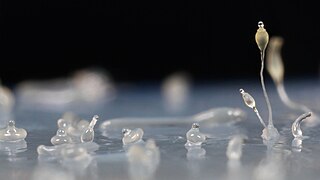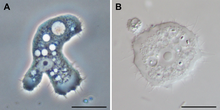
Amoebozoa is a major taxonomic group containing about 2,400 described species of amoeboid protists, often possessing blunt, fingerlike, lobose pseudopods and tubular mitochondrial cristae. In traditional classification schemes, Amoebozoa is usually ranked as a phylum within either the kingdom Protista or the kingdom Protozoa. In the classification favored by the International Society of Protistologists, it is retained as an unranked "supergroup" within Eukaryota. Molecular genetic analysis supports Amoebozoa as a monophyletic clade. Modern studies of eukaryotic phylogenetic trees identify it as the sister group to Opisthokonta, another major clade which contains both fungi and animals as well as several other clades comprising some 300 species of unicellular eukaryotes. Amoebozoa and Opisthokonta are sometimes grouped together in a high-level taxon, named Amorphea. Amoebozoa includes many of the best-known amoeboid organisms, such as Chaos, Entamoeba, Pelomyxa and the genus Amoeba itself. Species of Amoebozoa may be either shelled (testate) or naked, and cells may possess flagella. Free-living species are common in both salt and freshwater as well as soil, moss and leaf litter. Some live as parasites or symbionts of other organisms, and some are known to cause disease in humans and other organisms.

Lobosa is a taxonomic group of amoebae in the phylum Amoebozoa. Most lobosans possess broad, bluntly rounded pseudopods, although one genus in the group, the recently discovered Sapocribrum, has slender and threadlike (filose) pseudopodia. In current classification schemes, Lobosa is a subphylum, composed mainly of amoebae that have lobose pseudopods but lack cilia or flagella.

Amorphea is a taxonomic supergroup that includes the basal Amoebozoa and Obazoa. That latter contains the Opisthokonta, which includes the Fungi, Animals and the Choanomonada, or Choanoflagellates. The taxonomic affinities of the members of this clade were originally described and proposed by Thomas Cavalier-Smith in 2002.

The Apusozoa are a paraphyletic phylum of flagellate eukaryotes. They are usually around 5–20 μm in size, and occur in soils and aquatic habitats, where they feed on bacteria. They are grouped together based on the presence of an organic shell or theca under the dorsal surface of the cell.
The Vannellidae are a family of Amoebozoa, which are found in soil, fresh- and salt water. The most common genus is Vannella.

The Tubulinea are a major grouping of Amoebozoa, including most of the more familiar amoebae genera like Amoeba, Arcella, Difflugia and Hartmannella.

Discosea is a class of Amoebozoa, consisting of naked amoebae with a flattened, discoid body shape. Members of the group do not produce tubular or subcylindrical pseudopodia, like amoebae of the class Tubulinea. When a discosean is in motion, a transparent layer called hyaloplasm forms at the leading edge of the cell. In some discoseans, short "subpseudopodia" may be extended from this hyaloplasm, but the granular contents of the cell do not flow into these, as in true pseudopodia. Discosean amoebae lack hard shells, but some, like Cochliopodium and Korotnevella secrete intricate organic scales which may cover the upper (dorsal) surface of the cell. No species have flagella or flagellated stages of life.

Monadofilosa is a grouping of Cercozoa. These organisms are single-celled amoeboid protists.

Eumycetozoa, or true slime molds, is a diverse group of protists that behave as slime molds and develop fruiting bodies, either as sorocarps or as sporocarps. It is a monophyletic group or clade within the phylum Amoebozoa that contains the myxogastrids, dictyostelids and protosporangiids.

Leptomyxida is an order of Amoebozoa.
Dactylopodida is an Amoebozoa grouping.
Hartmannella is a genus of Amoebozoa.
Leptomyxa is a free-living genus of lobose naked multinucleate amoebae in the order Leptomyxida that inhabits freshwater, soil and mosses. It is very closely related to the genus Rhizamoeba, and some species have been moved between the two genera due to molecular data.

Rhizamoeba is a small genus of free-living marine naked lobose amoebae in the monotypic family Rhizamoebidae in the order Leptomyxida. It is most closely related to Leptomyxa and Flabellula, and some species have been moved to Leptomyxa due to molecular data.

Mayorella is a genus of small amoeboid protists in the phylum Amoebozoa. The genus consists of amoebae that exhibit pseudopodia and feed on a variety of organisms through phagocytosis, making them an important group in microbial ecology across most environments worldwide. Mayorella species have been found in soil, freshwater and marine environments.

The sarcomonads or class Sarcomonadea are a group of amoeboid biciliate protists in the phylum Cercozoa. They are characterized by a propensity to move through gliding on their posterior cilium or through filopodia, a lack of scales or external theca, a soft cell surface without obvious cortical filamentous or membranous skeleton, two cilia without scales or hairs, tubular mitochondrial cristae, near-spherical extrusomes, and a microbody attached to the nucleus.

An amoeba, often called an amoeboid, is a type of cell or unicellular organism with the ability to alter its shape, primarily by extending and retracting pseudopods. Amoebae do not form a single taxonomic group; instead, they are found in every major lineage of eukaryotic organisms. Amoeboid cells occur not only among the protozoa, but also in fungi, algae, and animals.
Cutosea is a small group of marine amoeboid protists proposed in 2016. It is a monotypic class of Amoebozoa containing the order Squamocutida. Cutosean organisms are characterized by a cell coat of microscales separated from the cell membrane. Four genera, Armaparvus, Idionectes, Sapocribrum and Squamamoeba, belong to this group, distributed in three families.

Evosea is a diverse clade of amoeboid protists discovered through molecular analyses. Along with Tubulinea and Discosea, Evosea is one of the three major groups within Amoebozoa, an important clade of eukaryotic organisms. It contains unicellular organisms that display a wide variety of life cycles and cell shapes, including amoebae, flagellates and different kinds of slime molds.

An amoeboflagellate is any eukaryotic organism capable of behaving as an amoeba and as a flagellate at some point during their life cycle. Amoeboflagellates present both pseudopodia and at least one flagellum, often simultaneously.












